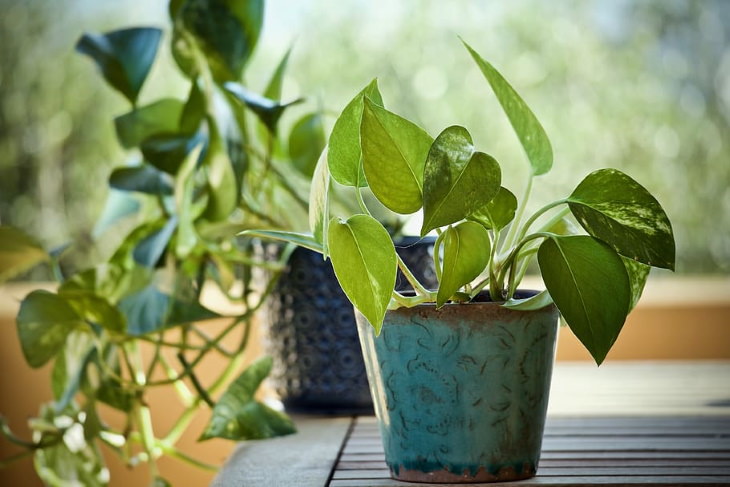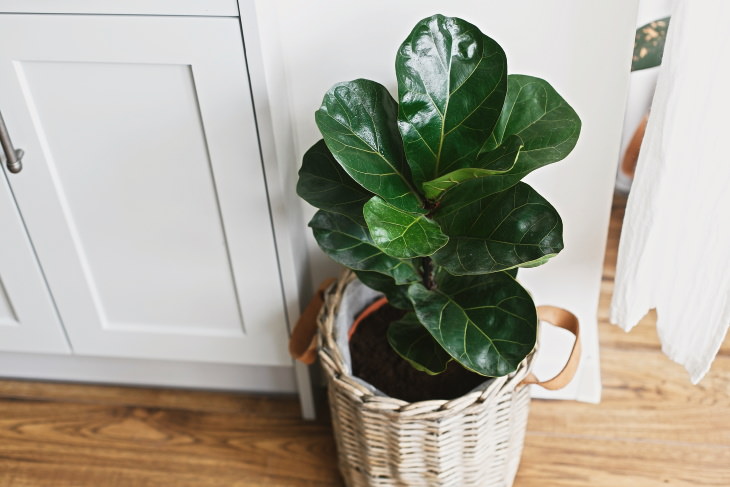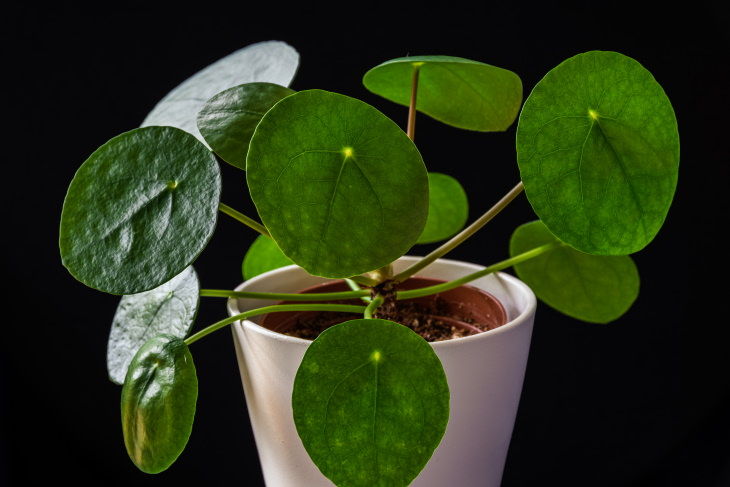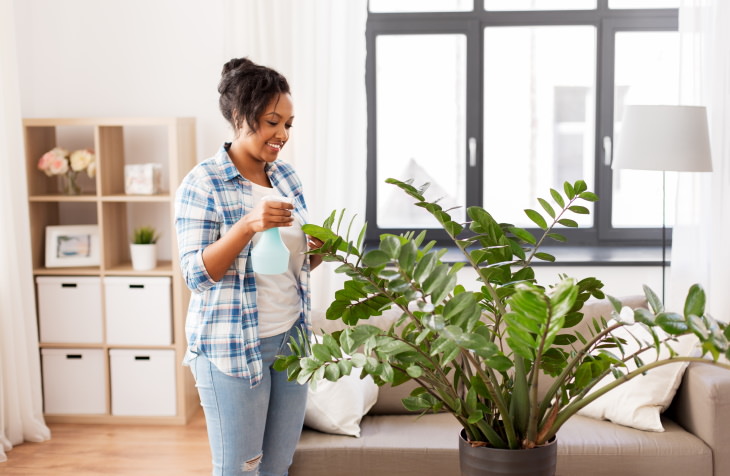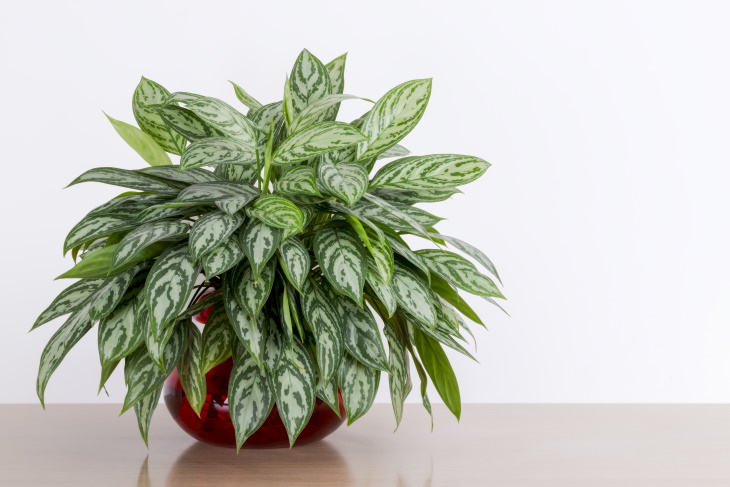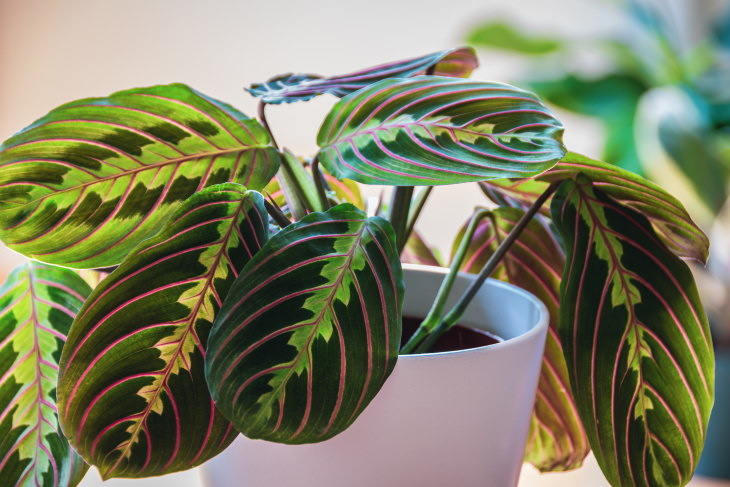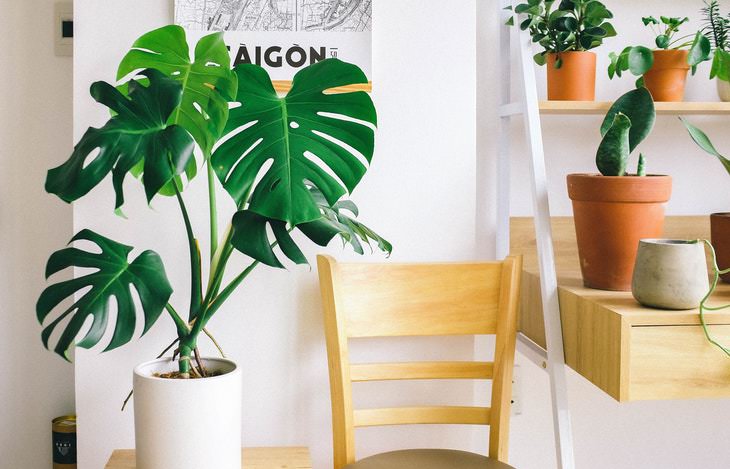1. Pothos (Epipremnum)
Pothos is an extremely widespread houseplant that comes in many color varieties, and one of the main reasons why it's so common is namely because it grows incredibly fast and is almost impossible to kill. Pothos plants are tolerable to dryness, in fact, they favor drying out between waterings. It's time to water your pothos when the leaves start to droop but try not to let the leaves wilt for long, as they may become yellow and fall off.
In addition to that, pothos doesn't require much light and are capable of surviving with little to no sunlight on artificial light alone. If you notice that the leaves of the plant become pale, it means they've had too much sun, whereas darker leaves can point to a lack of sunlight.
These trailing plants grow in long vines that can reach the length of 10 ft (3 m) or even more, but worry not, as the plant is very tolerant of trimming. In fact, you can easily take the cuttings, wait for them to root in water, and then replant in the same planter to create a fuller plant. To learn how to cut and replant pothos and a few other plants featured on this list, click here: How to Easily Propagate Different Indoor Plants. Keep your cats and other pets and children from chewing on pothos leaves, though, as they can cause irritation in the mouth, vomiting, and difficulty swallowing.
2. Rubber Fig (Ficus elastica)
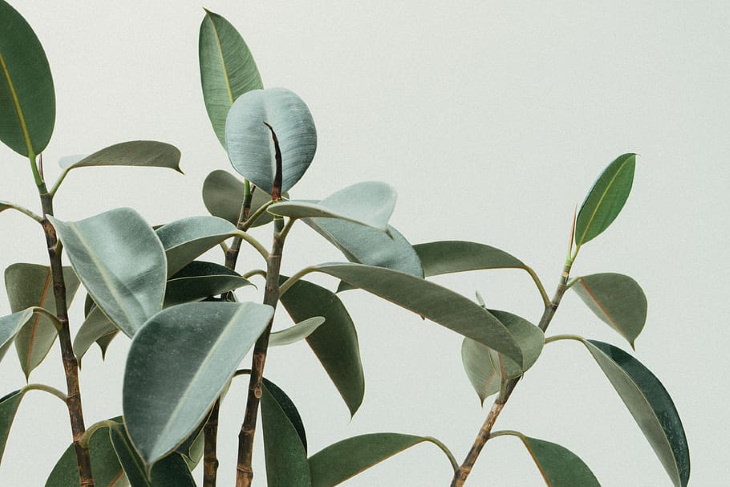
Another lush plant that will surely bring more interest to your interior is the rubber fig plant. Rubber figs can grow quite tall, and they have large glossy leaves that can either be dark green or purple. The beautiful indoor trees love the sun, so garden experts recommend placing them next to a south-facing window so that they bask in the sunlight.
Rubber figs grow naturally in a tropical environment, so they love a more humid climate, but that doesn't mean you must water the plant too often - once every 7-10 days is typically enough. To make the plant thrive in your home, though, especially if you live in a drier climate, what you can do is spray the leaves with some water once or twice a month to imitate that tropical humid climate.
If your plant is happy in its current location, it will grow quite fast - 24 inches (60 cm) or more in each growing season (mostly during late spring and summer), so you'll need to repot it once a year for the first few years while it's growing to the maximum size it can reach in your home. Rubber plants can cause irritation and digestive issues in pets when ingested.
Related Article: 12 Plants & Flowers That Are Easy to Grow At Home
3. Ponytail Palm (Beaucarnea recurvata)
That's right, you can easily grow an indoor palm in your home without having to worry or care for it much, really. A favorite of people who travel a lot, the Ponytail Palm, also known as Elephant's Foot, named for its thick trunk that resembles an elephant's foot, doesn't need watering more than once in a few weeks and enjoys a bit of drought. The plant is resilient to dry conditions because the trunk of the palm is rich in sap that holds in water very well. If the ends of the palm's leaves become brown, it means the plant is getting too much water.
Technically speaking, ponytail palms require bright sunlight, but because these plants are so forgiving, semi-bright light will do just as well. Finally, these plants are also one of the few palm trees safe for pets!
4. Flamingo Flower (Anthurium andraeanum)
The striking flowers of Anthurium will brighten up your home for 8 weeks or even more every year, so if you're looking for a flowering plant that's also low-maintenance, this is a good choice. The most common color these flowers come in is a bright red, but there are also the rarer varieties that bloom lavender, pink, white, or even green.
The plant itself isn't any less impressive, as the large, glossy heart-shaped leaves of the flamingo flower look quite cute, too. The plant requires medium or bright indirect light and barely moist soil, so it will make a great companion for most homes. Do note that the leaves of the plant contain toxic sap, so make sure pets and kids don't eat or bite them.
5. Fiddle Leaf Fig (Ficus lyrata)
Fiddle leaf fig trees are a trendy indoor plant, and we can certainly understand why, as the beautiful tree doesn't require much care once you find a good spot for it in your home. The plant does demand a lot of indirect light, though, so make sure it's close to a large window or keep it on a balcony altogether throughout the warm months if you live in a temperate climate. These trees do thrive in warmer temperatures, so make sure to keep the plant warm in the colder months and mist with water from time to time.
Fiddle leaf figs like to dry out a little between waterings, so do not overwater the plant and check every week or so if the soil has dried out or not. Water the soil evenly, and make sure the pot is well-drained to avoid root rot. Like rubber figs, the leaves of the plant can cause mouth irritation, vomiting, and other symptoms in cats, dogs, and children if ingested.
6. Chinese Money Plant (Pilea peperomioides)
This alien-looking plant may seem quite fragile, but don't be fooled by its appearance, as this is a really sturdy and undemanding little fella, which makes it the perfect beginner's plant. The tiny plant is known for its signature round leaves, which is why it's also sometimes called the Pancake Plant.
Unlike some of the other plants featured on this list, the Chinese Money Plant is quite compact, reaching the maximum height of about 8-12 inches (20-30cm), so it's a good one for those who don't feel like repotting or cutting the plant too often. As for the lighting conditions, pancake plants typically favor plenty of indirect light, as their leaves start to burn in the direct sun. No need to water the plant too often, especially in the colder months, as the plant actually favors a bit of drying out in-between waterings. Lastly, the Chinese Money Plant doesn't require extra humidity and is safe for pets and animals.
7. ZZ Plant (Zamioculcas Zamiifolia)
Another extremely popular plant these days is the so-called ZZ plant. The waxy leaves and thick branches of the plant hint to its exceptional ability to retain water in even the worst droughts. After all, the plant is native to Central Africa and has evolved specifically to deal with water shortages. This makes this interesting-looking plant an excellent choice for those who don't like to water their plants every week or two. Simply drizzle some water on the top layer of the soil, no need to saturate the entire soil, and you're done.
What's more, the ZZ plant doesn't even require that much sunlight, so just put it wherever you see fit, and if you see darkening of the leaves, move it to a place with more sunlight for some time. That said, do keep the plant away from kids and pets, as well as handle it carefully yourself, as the ZZ plant contains calcium oxalates, which are often irritating both internally and externally.
8. Chinese evergreen (Aglaonema commutatum)
Considered one of the most resilient and fuss-free foliage plants, the Chinese evergreen likes low and medium light and can live for a decade or even more. The plant grows quite slowly, reaching a maximum size of 1-3 ft in diameter (30cm-1m). Chinese evergreens are the perfect plant to keep on the living room table, as it doesn't require much light and its colorful lance-shaped leaves will look quite appealing to the eye.
Water the soil of the plant evenly once in a few weeks and let it dry out a little between watering to prevent root rot or fungal infections. You can also mist the leaves from time to time. Keep the plant away from pets and kids, as it is poisonous when ingested.
9. Prayer plant (Maranta)
It's easy to tell why prayer plants are so popular, as their large colorful leaves are quite impressive and instantly become the centerpiece of any interior. There are many kinds of prayer plants, ones with bright pink, orange, and purple stripes and spots, among others, and all of them are quite low-maintenance.
These pretty plants grow best in a moderately sunny and warm spot, and they, too, love humid environments, as they have originated from the Amazon, so mist it once a week. Watering the plant too often isn't a good idea and can cause root rot, but the plant does favor a moderately-moist soil. While these plants are safe for pets, they do tend to attract indoor pests, so take a look if no unwanted residents have settled on the plant from time to time.
10. The Swiss Cheese Plant (Monstera Deliciosa)
Monstera deliciosa is one of the most photo-friendly and beautiful plants out there, but it's also crazy easy to grow, and very low-maintenance. Commonly known as the Swiss Cheese Plant for its characteristic holes in the leaves, monsters happily embrace a variety of climates and only require watering once a week.
Do keep in mind, however, that monsteras are extremely fast-growing and will expand by 28 inches (71 cm) in size every year, so make sure you have plenty of space in the room that will serve as its home. The plant likes a lot of indirect light, but other than that, it's very straightforward in terms of care. As the previous feature on this list, though, chewing monsteras can lead to irritation and vomiting in pets and humans. Also, you shouldn't break the leaves and stems of the plant without gloves to avoid skin irritation.
Enjoyed this read? Why not share it with others, then?

